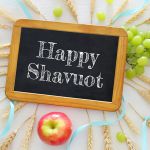“Teach us to number our days, that we may gain a heart of wisdom.” (Psalm 90:12)
Tonight begins the traditional Jewish holiday of Lag BaOmer (33rd Day of the Omer count). As its name suggests, this festive day occurs on the 33rd day of the Biblical counting of the Omer, an appointed practice explained later in this feature.

Orthodox Jewish men dance and rejoice on Lag BaOmer in Meron, the location of the tomb of Mishnaic-era sage Rabbi Shimon bar Yochai. Tens of thousands of visitors are drawn here during Lag BaOmer to pray and celebrate. Many camp out for days.
Counting the Omer
While the origins of this minor holiday are not entirely known, a 13th century reference in the Talmud mentions that a plague suffered by the students of first century Rabbi Akiva ended on this day. According to the Talmud, 24,000 of Akiva’s students died in a Divinely sent epidemic because they did not show each other proper respect.
Rabbi Akiva lived soon after the death and resurrection of Yeshua (Jesus), circa AD 40–130. He is referred to in the Talmud as the Head of the Sages, since he was a major contributor to the Mishnah and Midrash Halakah (rabbinic teachings).
After the plague ended, Rabbi Akiva had only five students—one of them was Rabbi Shimon bar Yochai, who is considered in Judaism to be a great sage and mystic. He is the author of the Zohar (Radiance)—the primary literature of Jewish mysticism.
In addition to being the date that Rabbi Akiva’s plague ceased, the Talmud also identifies the 33rd day of the Omer count as the anniversary of Rabbi Yochai’s passing.

Rabbi Eliezer Berland shoots arrows with a bow near Bar Yochai’s tomb in Meron, Israel during Lag BaOmer. Archery is a Lag BaOmer custom that, to some, represents Bar Yochai’s words which were shot like arrows, bringing repentance.
In Israel, Lag BaOmer is celebrated with the building and lighting of enormous bonfires that traditionally represent the light that emanated from Rabbi Yochai.
Throughout Israel tonight, the night sky will be dotted with the bright lights of a vast host of fires, and the air will be filled with the smoke of their burning planks, timbers, and branches.
In early Israel, however, the Zionist movement saw Lag BaOmer as a celebration of the Bar Kochba revolt against the Romans that took place AD 132–136. Children’s textbooks painted Bar Kochba as a hero, pushing Rabbi Shimon bar Yochai and Rabbi Akiva aside.
Bar Kochba’s victories were celebrated by singing and dancing around bonfires at night (representing the torches lit on mountaintops by rebels to signal each other) and playing with bows and arrows by day to celebrate the rebels’ warrior archery.
Many youth programs are especially active this week, including the Israel Defense Forces Gadna pre-army youth brigade, which was instituted in pre-state Israel (1941). Its emblem is a bow and arrow.
Still today, this holiday is symbolic of the Jewish fighting spirit.
Counting of the Omer and the Giving of the Torah (Instructions)
Lag BaOmer falls within the Biblically appointed time called Counting of the Omer (Sefirat HaOmer). This is a period of 50 days that begins on the second night of Passover and ends on the Feast of Shavuot (Pentecost).
According to the Midrash Rabbah (rabbinic teachings), when the Israelites left Egypt, Moses told them that in 49 days they would receive the Torah.
After having been slaves in Egypt, the people were so excited at the prospect of this spiritual emancipation that they kept a count of the passing days ending with the giving of the Torah at Mount Sinai.
Biblically, the instructions for Counting the Omer are given to Moses by God among several other appointed days. For the counting of the Omer, God told Moses:
“From the day after the Sabbath, the day you brought the sheaf [measure of barley] of the wave offering, count off seven full weeks. Count off fifty days up to the day after the seventh Sabbath, and then present an offering of new grain [wheat] to the Lord.” (Leviticus 23:15–16)
Rabbinic literature considers the question of why barley is offered on the first day of the count, while on the last day, the Feast of Shavuot, wheat is offered.
The conclusion according to Hassidic thought is that barley is traditionally considered a staple food for animals, while wheat is considered a staple food for humans.
The rabbis, therefore, describe this 50-day period as being a time for spiritual growth and character development from our animalistic desires toward becoming a more holy, spiritual human being who is made in the image of God. (Chabad)
We are not to become satisfied with whatever level of spirituality we have reached, either. We are to always set goals to reach higher levels.
We see this growth historically when, at the beginning of the first Omer count, the Hebrews were lifted out of their exile in Egypt as a people worked and owned like animals, but at the end of their Omer count on the 50th day, they received God’s Torah and the spiritual elevation that accompanies that.
The 50th day is called Shavuot (Weeks) or Pentecost (Fiftieth), in recognition of the seven weeks or seven sevens that have been counted off.
Today, we continue to count the Omer in anticipation of receiving the Torah, which we symbolically receive anew each year on the 50th day, Shavuot.
In fact, Yeshua’s talmidim were in Jerusalem on Shavuot, the day that the Ruach HaKodesh was poured out, for this very purpose. They were there in obedience to both the Torah, which commands the Jewish People to go up to Jerusalem on Shavuot, and to Yeshua’s command to stay there until they were clothed with heavenly power.
Yeshua essentially told them to stay in Jerusalem for the counting of the Omer. And while they were there counting the Omer, they were preparing themselves to both renew their commitment to the Torah and to receive power from on high.
“And, behold, I send the promise of My Father on you: but tarry you in the city of Jerusalem, until you be endued with power from on high.” (Luke 24:49)
While God’s Torah was an unearned gift, our aspirations for spiritual growth and holiness require our effort; therefore, these 50 days are traditionally a period of looking within ourselves and dealing with our negative attributes. For example, if we realize that we are not giving enough, we can use this time to put away our self-centeredness and go out of our way to do acts of kindness or charity for others.
Believers can also call on the Ruach HaKodesh (Holy Spirit) to help us identify areas of our hearts, minds or actions that are not aligned with the character and purposes of God. We can ask Him for the help, courage, and strength to change.
The Ruach HaKodesh was poured out on the first Believers who were in Jerusalem during the Counting of the Omer and the Feast of Shavuot. They had been preparing themselves, as Yeshua told them.
While many Rabbis and sages have been thought of as being enlightened, even emanating light out to the world, only Rabbi Yeshua is the Light of the World. (Psalm 36:9; Malachi 4:2; John 1:4, 12:46)
As the source of Divine light, He personally opened the eyes of the Talmidim to understand the Messianic prophecies concerning Him. (Isaiah 48:8; John 20:22)
On Shavuot, the Ruach empowered them with special giftings, as well as courage to announce that Messianic knowledge to the world—and He is still doing so today. (Joel 2:28; Acts 2)
We will write more about the Feast of Shavuot and the Ruach HaKodesh during the appointed time on the Jewish calendar—Sivan 5–7 (May 23–25).
How the Omer Is Counted
The Omer is counted every night during this 50-day period, beginning on the second night of Passover and ending on Shavuot (Pentecost).
When it is assured that the sun is down, or approximately 30 minutes following the sunset, the one who is counting recites the following blessing in the synagogue:
Baruch atah A-donai E-loheinu Melekh Ha-olam asher kid’shanu b’mitzvotav v’tzivanu al S’firat Ha-Omer.
Blessed are You, Lord our God, King of the Universe, Who has sanctified us with His commandments and commanded us to count the Omer.
The count is recited in Hebrew with the day given as both total days as well as weeks and days. So a typical count for the 33rd day is “Today is 33 days, which is four weeks and five days of the Omer.”
The count must be made during the night; however, if a person forgets to count at night but remembers to count the following morning, it can still be made but without the blessing. It can also be made in any language.
Looking Forward to the Messiah’s Return
During the time of the Temple, barley at the beginning of the Omer count and wheat on Shavuot were brought as “wave offerings”—that is, they were waved in all directions before the Lord much as the Lulav (a closed frond of the date palm tree) is waved on Sukkot in recognition of the all-encompassing Presence of God. (Chabad)
At the beginning of this year’s counting of the Omer, the Temple Institute in Jerusalem re-enacted the barley offering on the second day of Passover—the same day that it was traditionally performed in the Temple. In doing this, they were preparing for the reestablishment of the Third Temple and the coming of the Messiah.
As the Jewish People prepare for the Messiah’s coming, Believers all over the world wait in anticipation for His soon return—Jews and Gentiles.
The counting of the Omer is a part of that anticipation, the positive expectation that we will soon see Messiah Yeshua when He comes to set up His kingdom on earth.
Let us all be prepared for that day and that final coming.


















